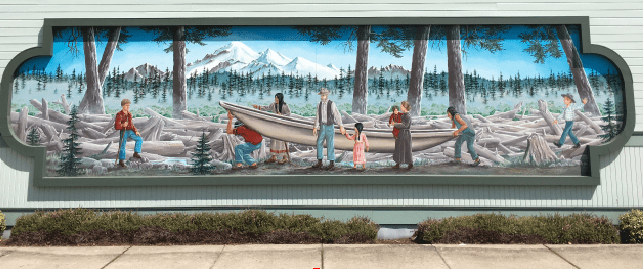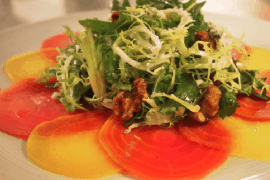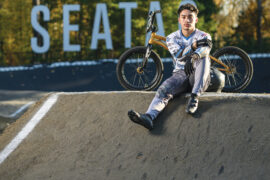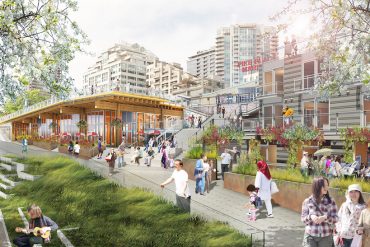Great Depression era murals still shine
written by Beau Eastes
Tucked in Nooksack Valley just 5 miles south of the Canada border, Lynden is full of surprises for any adventurous wanderer willing to get off the beaten trail.
Lose yourself in the shelves of Village Books, downtown’s enchanting three-story bookstore, or spend the evening drinking to a good cause at Overflow Taps. Check out the towering “Three Ages of Phoebe Goodell Judson” mural at the Lynden post office, one of the Pacific Northwest’s most vivid examples of art commissioned during the Great Depression by the federal government to beautify public buildings and provide relief for out-of-work artists.
Treasures Hidden in Plain Sight
Scattered throughout rural Washington in non-descript post offices, courthouses and libraries is a treasure trove of fine art created by some of America’s top artists of the twentieth century.
Products of the Treasury Department’s Section of Painting and Sculpture division, which operated between 1934 and 1943—not the Works Progress Administration, which was responsible for constructing post offices, courthouses and libraries—these murals and wood reliefs were part of a nationwide effort by the U.S. government to provide art for the people.
The program was incredibly effective, as more than 1,100 murals and 300 sculptures were completed and displayed throughout the country. In Washington alone, eighteen post offices from all across the state—from Colville to Clarkston to Camas and everywhere between—received murals, including Lynden.
While most of the murals in Washington depict historical scenes of local importance—the Bremerton mural highlights the logging industry while the Anacortes painting pays tribute to halibut fishing—none captures the triumph of an individual like “Three Ages of Phoebe Goodell Judson.”
Painted by Mordi Gassner, a two-time Guggenheim grant winner who studied at Galleria dell’ Accademia in Florence, “Three Ages” is a glowing tribute to Phoebe Goodell Judson, the first non-Native American woman to live in Lynden. The mural portrays her arrival in the Nooksack Valley in 1870, her contemplative middle years and the fruits of her and her fellow settlers’ labor.
This is a white, Protestant perspective of the history of northwest Washington from a Jewish New York City painter who studied in Italy and admired the works of Mexican muralist Diego Rivera. Gassner had little control over the subject matter as the Lynden project committee not only chose the theme for the mural, but the name as well. It’s one of the more fascinating pieces in Washington—completed in 1942, it’s still hanging in the Lynden post office—but hardly the only one.
The Saga of Wenatchee
For art adventurers seeking a piece that’s impressive for its sheer magnitude, head to Chelan County for the epic “The Saga of Wenatchee” at the Wenatchee Valley Museum in Wenatchee. Painted by Tacoma artist Peggy Strong, who won a statewide contest for the right to create the piece, “The Saga” imagines what life was like in the Wenatchee Valley for its first white residents—over an entire wall.
Strong, who was paralyzed from the waist down at 21 after a car accident, painted “The Saga” with the help of a motorized scaffolding device that her father built. She went on to paint other murals, including one in Tacoma’s Union Station, before dying at the age of 44 in 1956. A recent reexamination of her work led to a retrospective show at the Cascadia Art Museum in Edmonds this past winter.
Still Public, Still Captivating
Most of the pieces in Washington and their creators have stories worth learning.
In Clarkston, Donlon McGovern’s “Lewis and Clark” wood sculpture was forgotten even before it was displayed. McGovern and his wife visited the Clarkston post office sometime in the 1960s and asked about the piece. It had been sitting in the building’s basement for twenty years. A man of many talents, McGovern later went on to become a design engineer for NASA’s Apollo Project.
A former Russian soldier, Jacob Elshin, painted murals in Renton and Seattle’s University District, and David McCosh, who would go on to become a legendary art teacher at University of Oregon, painted a Lewis and Clark mural in Kelso.
If you needed an excuse to explore the less-visited areas of the state, here it is. Most of Washington’s post office art commissioned by the Treasury Department is in its original location and open to the public, whether the building is serving as a post office or not. The next time you go through Anacortes or Kelso or Kent, take a minute to swing by an old post office and soak up a piece of Washington state history.
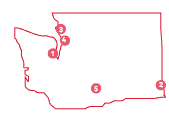
There are eighteen Great Depression-era murals around Washington. In addition to those in Wenatchee and Lynden, here are a few more post office murals for you to check out. For the full list, go to 1889mag.com.
1. Bremerton:
“Northwest Logging”
– Ernest Norling
2. Clarkston:
“Lewis and Clark”
– Donlon P. McGovern
3. Anacortes:
“Halibut Fishing”
– Kenneth Callahan
4. Mount Vernon
(at Skagit Valley College):
“Local Pursuits”
– Ambrose Patterson
5. Toppenish:
“Local Theme”
– Andrew McDuffie Vincent


